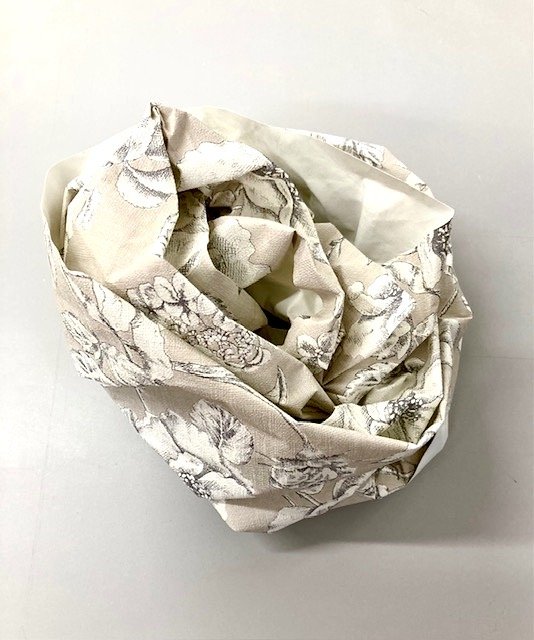All of a sudden, “it’s all about filling the space”1, to quote Phyllida Barlow, the grande dame of grand, sprawling, sculptural installations. The week leading up to deadline day has been one of frenzied clearing, painting, collating materials and panic, which has really put the pressure on me in preparing a large site-specific work. I’ve worked relentlessly over the months, but still it’s not been enough. It’s been frustrating given that the large seminar room is also the area where the painting equipment is stored, so there is no way that I could get painting the last rolls. But finally the OK was given and we can start the installing. I have three and a half days to do this. Plus the evaluation statement. Plus this last post.
Sketch of the entrance to Spring Crush. Photo Shirley A
At the end of the first day, I’m almost in tears with the pressure of having the prime space in the show. It’s got to be right. It’s got to fill the space. After a pep talk with Johanna, Clarissa is assigned to help me. She is an absolute star: not only is she a hard, diligent worker, making suggestions about positioning the pieces and reminding me of things I’d forgotten, her sunny personality lifts my spirit and my energy levels are boosted.
Armature for the main structure, which will be sited at the back left of the installation. Several layers will be added, giving heft and grounding its presence. Photo Shirley A
One of several iterations in bulking up the armature and adding other packaging materials to give different textures. This model needed heft, so the decorative outer elements were removed and plain layers added before deciding on the final, coloured layer. Photo Shirley A
We both have fun with constructing the pieces – rolling, unrolling several times – damn this paper wanting to do its own thing. “Sculpture unfolds and refolds and unfolds again. It’s extremely restless.”2 With twine, staples, we get it under control. But it takes time. There has to be a better way of managing the work. I’ll be better able to assess this in reflection later in the summer.
A maquette of Spring Crush’s floorplan. Photo Shirley A
Working out the positioning of the structures and their individual shapes using the maquette and images taken of the Songenchi and Saihoji gardens in Kyoto. Photo Shirley A
The bulk of my work this year has been not actually producing any finished work, it’s all been about the preparation for the final install. So, when I follow up a passing comment from an MA student that I should look at The Fold, I learn that my work is a physical manifestation of what Deleuze described as baroque. While I have over the past few months folded, twisted and crushed the rolls kraft paper using the top half of my body in preparation for painting it, the real physical job of creating my structures comes now, when my entire physical and mental being is involved in their creation. In my head: sings “… the Baroque trait twists and turns its folds, pushing them to infinity, fold over fold, one upon the other.”3
This wallpaper remnant was constructed with the most simplest of folds - wrapping it around my lower arm and then tucked in - and stayed in position without needing any moulding. It won’t be used for this project as the pattern doesn’t quite fit in with the rest of the pieces, but it’s definitely a material for a future project. Photo Shirley A
As I write this, I’m having a break from the install and panicking a bit. Time to submit this, finish the install, clear up and go. I think I owe Clarissa a drink or two.
Alistair Sooke and Edith Delaney, Phyllida Barlow: Cul-De-Sac [London: Royal Academy of Arts, 2019] p.10.
Alistair Sooke, ibid. p.10.
Gilles Deleuze, Tom Conley (trans.), The Fold: Leibniz and the Baroque [London: The Athlone Press, 1993] p.3.





